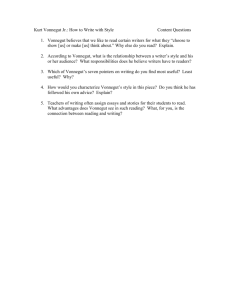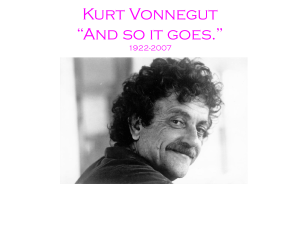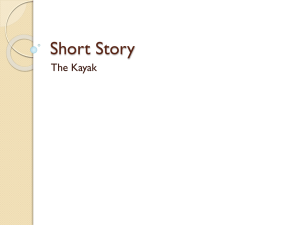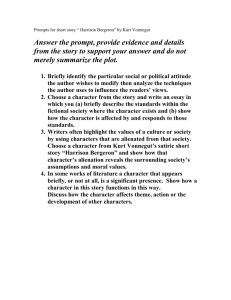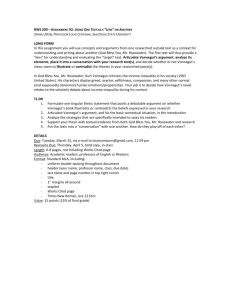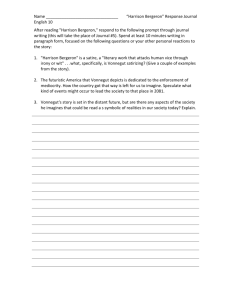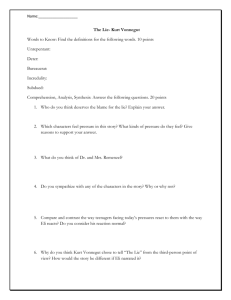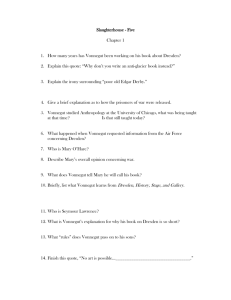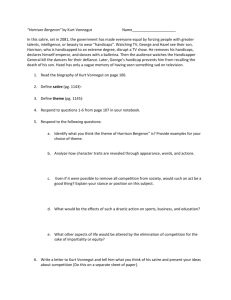Brendan Mateer 12/07/2010 ENGL 2132 Prof. J.E. Bishop The
advertisement
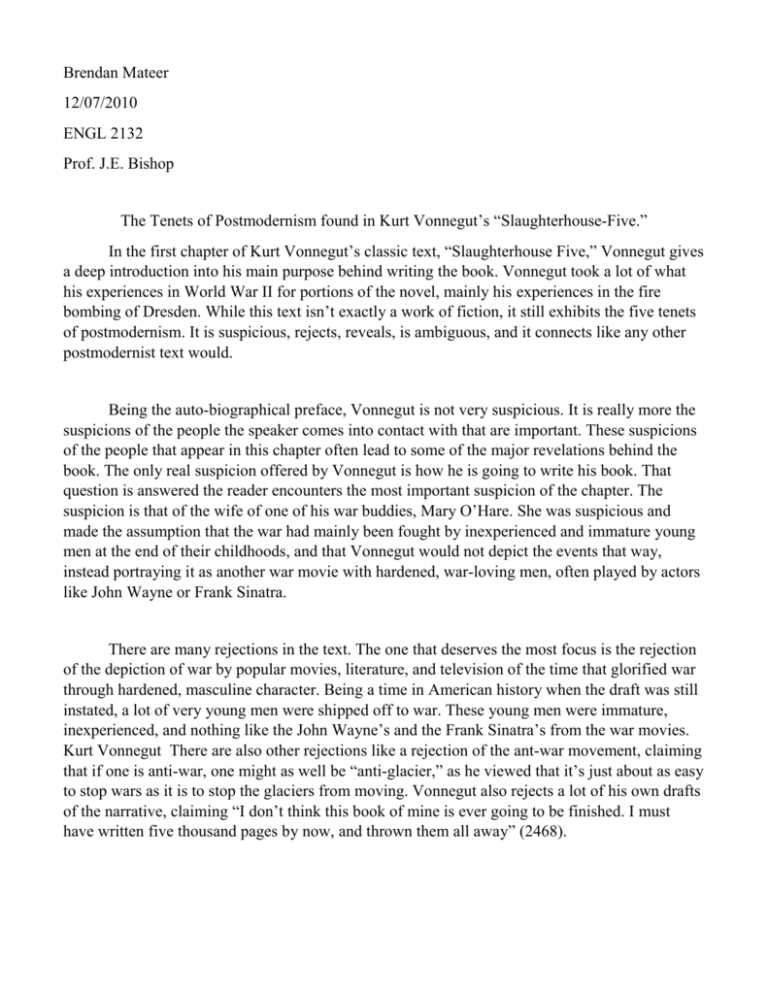
Brendan Mateer 12/07/2010 ENGL 2132 Prof. J.E. Bishop The Tenets of Postmodernism found in Kurt Vonnegut’s “Slaughterhouse-Five.” In the first chapter of Kurt Vonnegut’s classic text, “Slaughterhouse Five,” Vonnegut gives a deep introduction into his main purpose behind writing the book. Vonnegut took a lot of what his experiences in World War II for portions of the novel, mainly his experiences in the fire bombing of Dresden. While this text isn’t exactly a work of fiction, it still exhibits the five tenets of postmodernism. It is suspicious, rejects, reveals, is ambiguous, and it connects like any other postmodernist text would. Being the auto-biographical preface, Vonnegut is not very suspicious. It is really more the suspicions of the people the speaker comes into contact with that are important. These suspicions of the people that appear in this chapter often lead to some of the major revelations behind the book. The only real suspicion offered by Vonnegut is how he is going to write his book. That question is answered the reader encounters the most important suspicion of the chapter. The suspicion is that of the wife of one of his war buddies, Mary O’Hare. She was suspicious and made the assumption that the war had mainly been fought by inexperienced and immature young men at the end of their childhoods, and that Vonnegut would not depict the events that way, instead portraying it as another war movie with hardened, war-loving men, often played by actors like John Wayne or Frank Sinatra. There are many rejections in the text. The one that deserves the most focus is the rejection of the depiction of war by popular movies, literature, and television of the time that glorified war through hardened, masculine character. Being a time in American history when the draft was still instated, a lot of very young men were shipped off to war. These young men were immature, inexperienced, and nothing like the John Wayne’s and the Frank Sinatra’s from the war movies. Kurt Vonnegut There are also other rejections like a rejection of the ant-war movement, claiming that if one is anti-war, one might as well be “anti-glacier,” as he viewed that it’s just about as easy to stop wars as it is to stop the glaciers from moving. Vonnegut also rejects a lot of his own drafts of the narrative, claiming “I don’t think this book of mine is ever going to be finished. I must have written five thousand pages by now, and thrown them all away” (2468). The most important revelation of the chapter also stems from the most important suspicion of the chapter by Mary O’Hare. When Vonnegut is confronted with her suspicion and assumption, he vows to her that he will not depict his war story as she thought he would with hardened, war loving men, but as things actually happened in the war. He then promised to call his narrative “The Children’s Crusade,” after the events that occurred in 1213 A.D. This made the full title of the book “Slaughterhouse-Five or The Children’s Crusade,” but the book would become more commonly known by its full title. The chapter goes on to reference a passage from a book about the events that took place during The Children’s Crusade of 1213, revealing why he chose the to title his narrative as such. Though auto-biographical texts are normally rather strait forward and with one meaning, Vonnegut still manages to squeeze a few instances of ambiguity. For instance, his decision to title his narrative “The Children’s Crusade” can be taken as a reference to the events of 1213 or that he was going to depict that the war was fought by young men, who were practically children. Early on in the novel, Vonnegut references a Christmas card that a war buddy of his, Bernard V. O’Hare, received from a cab driver when they returned to Dresden after the war. The card read, “I wish you and your family also as to your friend Merry Christmas and a happy New Year and I hope that we’ll meet again in a world of peace and freedom in the taxi cab if the accident will” (Vonnegut 2462). The ambiguous part of that sentence is the last four words, “if the accident will.” This can cause the entire sentence to be interpreted in two different ways. The words can be interpreted as the world attaining peace being so improbable and that the only way it could is by accident, or it could be interpreted as that the two of them would find their ways to his cab again by accident. The text provides excellent examples of connectivity in literature. Vonnegut’s decision to title his narrative “The Children’s Crusade” is an excellent example of that connectivity. Vonnegut used that title to connect World War II to The Children’s Crusade of 1213 AD, when thirty thousand French and German children were rounded up by monks and were either sold as slaves in North Africa, died en route to North Africa, or were lucky and actually ended up in Genoa, Italy where they were questioned and sheltered by the people there and sent home. That point in the story also appears to be the climax of the text, and the point where all of the tenets of post modernism are connected. With these examples, one can see the tenets of post modernism present within the text. The text is clearly suspicious, it rejects, reveals, is ambiguous, and is connective by using themes like The Children’s Crusade of 1213 AD and the possibility of peace in a world of humans who have very violent natures. Works Cited Vonnegut, Kurt. “Slaughterhouse-Five.” 1969. The Norton Anthology American Literature Seventh Edition Vol. E. Eds. Klinkowitz, Jerome, and Patricia B. Wallace. New York: W.W. Norton & Company, 2007. 2461-2472. Print.
